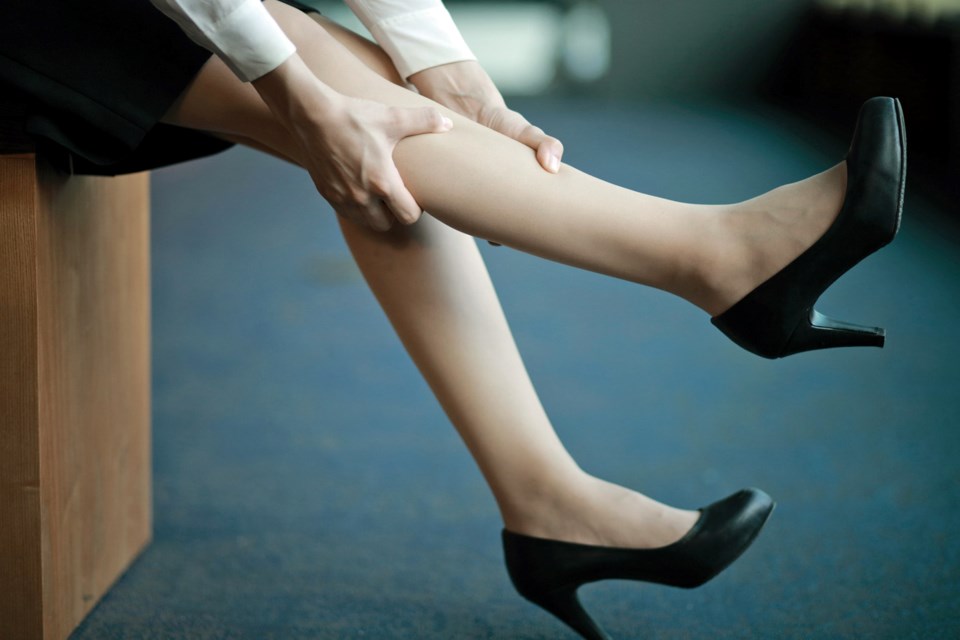In Caitlin Moran’s book How to be a Woman, she comments that heels made women less able to run from assailants and kept women vulnerable and needing a man’s arm to steady them. Much feminine fashion was established by men throughout history and the high heel is no exception. It is unclear if the intention of the high heel was to keep women bound to men but they certainly cause physical disabilities while wearing them as well as long-term issues.
Heeled sandals were worn in ancient Egypt by both genders of the upper class to indicate wealth and status above the working class, as one couldn’t work in high sandals. The heel elevated someone’s position above commoners. The Persian cavalry wore high heeled boots to keep their feet in the stirrups when they stood up to shoot arrows, and when coming to Europe the idea of heels for men took hold. During the medieval period in Europe, platform shoes were worn by men and women to rise above the excrement filled streets. High red heels were a favourite of Louis XIV (as he was a short king) and became part of French fashion. Eventually men’s shoes became broader and sturdier, while women’s shoes became narrower, higher and more ornamental. Men stopped wearing heels in the mid 1700s as they became more associated with lady’s fashion. The female high heels became a symbol of grace and demure in Europe.
During the Second World War and the popularity of pin up posters, the women were always pictured wearing high heels as it made the feminine leg more shapely. In the minds of the men at war and also in general American culture, these posters were greatly responsible for the relationship between high heels and sexually objectifying women. The tall stiletto heel from the 1950s became a symbol of female sexuality and the fascination with high heels continues on.
What the high-heeled wearers didn’t think of then was the many long-term health issues associated with high-heeled shoes. And even though we know better now, we are still fascinated by high heels. It is a strange obsession/relationship when you think of it. Stiletto heels are a significant part of the wardrobe of many professional women and in fact, the higher a woman is paid, the more likely she is to wear heels to work.
Attention to what women wore on their feet did not start in Europe. Foot binding in Asian cultures (particularly China) was a thousand-year-old tradition that was excruciatingly painful and caused mutilated feet for female children and women. Binding the feet made them smaller in order to fit into tiny triangle shaped shoes, and small feet made the women seem more attractive and subservient in the eyes of men. Foot binding was finally outlawed in 1912, but the last manufacturer of the triangle shoe only shut down a few years ago. It is estimated that over two billion Asian women faced this agony in the name of fashion.
When we wear high heels, our body weight is shifted forward causing our toes to squish and the balls of our feet to absorb all the pressure when we walk or stand. This can lead to hammer toes, fallen arches, ingrown toenails, callouses, bunions, corns, heel spurs, planter fasciitis, hallux valgus deformity and other long-term painful issues in our feet.
But it isn’t just our feet that are affected in the long run. Heels cause a higher risk of structural issues like lower back pain, knee problems, hip issues, nerve damage and injury to the Achilles tendon and calf muscles. In fact, the higher the heel, the higher the risk of permanent damage. Not to mention the risk of falling.
According to WCB, a high percentage of women working as servers in the restaurant industry report they have slipped, tripped or fallen as a direct result of wearing inappropriate footwear. Despite this, there are many restaurants that have high heels as their suggested dress code even though they can’t legally penalize an employee for refusing to wear them. But if they want shifts, the young women usually pay the price and don the heels without thinking about the health hazards.
The problem is that many young women cannot imagine that they will be anything less than young. They cannot imagine being their mothers or grandmothers some day. With youth and beauty often comes a serious case of denial, so it is to these young women that I dedicate this article. Please realize that few of us (the middle agers or older) ever considered the health issues we would face from our youthful choices and there are plenty of us paying the price now. Aging doesn’t have to be painful and wrought with health issues, but prevention is key.
To your graceful beauty without damaging your precious feet.
Claire Nielsen is a health coach, author, public speaker and founder of www.elixirforlife.ca. The information provided in the above article is for educational purposes only and is not a substitute for professional health and medical advice. Please consult a doctor or healthcare provider if you're seeking medical advice, diagnoses and/or treatment.

